For additional information relating to this article, please contact:
August 26, 2021EMPLOYMENT, EARNINGS AND HOURS, JUNE 2021 Please note that an earlier version of this article had included incorrect dates in some chart titles, the correct version is below.
PAYROLL EMPLOYMENT
With June reference month results, year-over-year (June 2021 vs June 2020) and year-to-date (Jan-Jun 21 vs Jan-Jun 20) are showing the rebounds in economic activity from the unprecedented declines observed at the start of the COVID-19 pandemic.
Nova Scotia had 410,089 payroll employees in June 2021, up 0.3% (+1,307) compared to May 2021, and up 10.8% (+40,105) compared to June 2020. Nova Scotia's payroll employment had been trending upwards since 2017 but declined sharply between February and May 2020 due to restrictions and closures resulting from COVID-19. There was a partial rebound from June to November due to eased restrictions. In December 2020, Nova Scotia's payroll employment edged down once again on renewed COVID-19 restrictions. Nova Scotia's payroll employment returned to a path of recovery starting in January 2021. Nova Scotia imposed restrictions again at the end of April. These restrictions were eased part-way through June. The gains in June reflect the easing of these restrictions.
Canada had 16.3 million employees, an increase of 1.3% (+214,818) compared to last month and up 13.2% (+1,901,676) compared to a year ago.
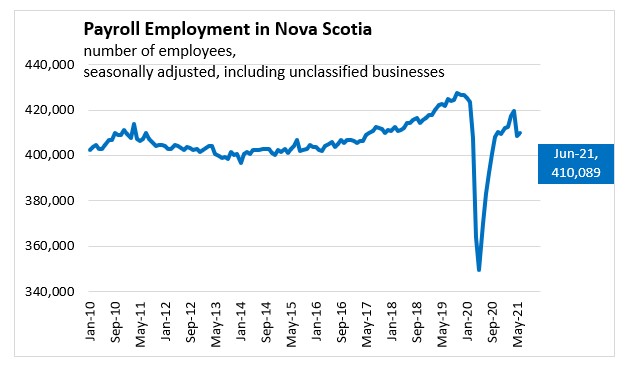
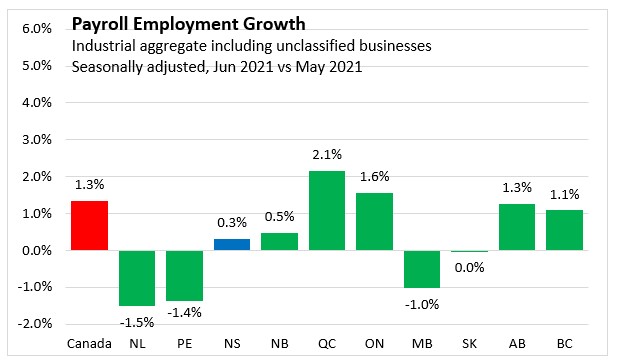
Compared to February 2020, Nova Scotia's payroll employment was down 3.2% in June 2021. Nationally, payroll employment was down 4.5% in June 2021, with all provinces reporting decreases except New Brunswick (+1.5%). The largest payroll employment declines were observed in Ontario (-6.8%) and Alberta (-5.7%).

In Jan-Jun 2021, Nova Scotia's payroll employment increased 6.0% over Jan-Jun 2020. Nationally, payroll employment rose 4.3% in Jan-May 2021, with all provinces reporting increases. The slowest payroll employment growth was observed in Alberta (+2.3%) and Ontario (+2.8%). The largest payroll employment increases were observed in Prince Edward Island (+8.6%) and New Brunswick (+8.1%).
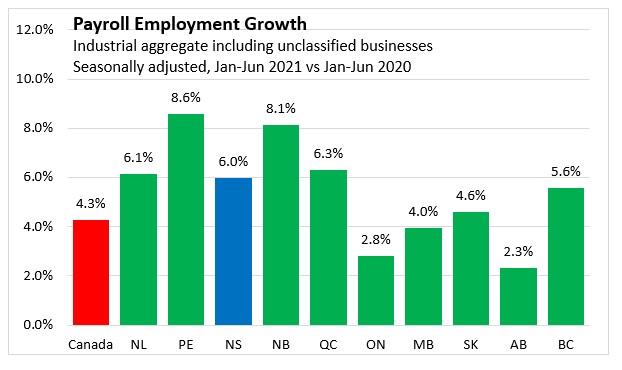
In January-June 2021, payroll employment was up 7.5% in Nova Scotia's goods producing sectors compared to January-June 2020. Goods sector payroll employment was up in all sub-sectors with forestry/logging (+10.5%) recording the largest gain.
Service sector employment was up 5.7% in January-June 2021 compared to January-June 2020. Service sector payroll employment increased the most in percentage terms in management of companies and retail trade. Payroll employment decreased in real estate/rental & leasing and information & culture.
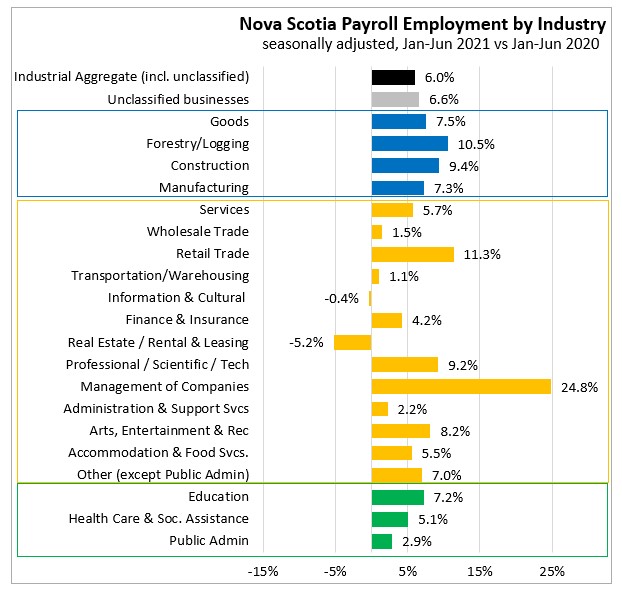
AVERAGE WEEKLY EARNINGS
Changes in average weekly earnings reflect wage growth as well as changes in the composition of employment by industry/occupation/experience, and average hours worked per week. During COVID-19, large employment losses have been reported in industries with relatively low average weekly earnings. This means that average weekly earnings were increasing because those remaining employed are working in industries with higher average weekly earnings. Declining average weekly earnings may similarly reflect re-employment in lower wage industries.
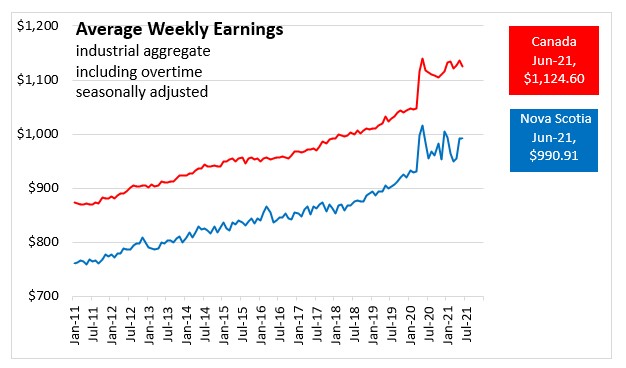
Nova Scotians' average weekly earnings (including overtime, seasonally adjusted) was unchanged from the previous month in June ($990.91). Average weekly wages were up 0.7% compared June 2020. Canadians' average weekly wages declined 1.0% month to month ($1,124.60 in June) but were 0.7% above wages a year ago.
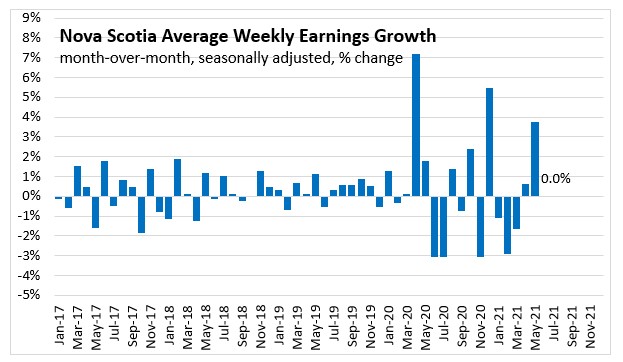

Across the country, there were monthly increases in three provinces, with the largest increases in Prince Edward Island (+2.7%). The largest decline was in Ontario (-2.2%).
Compared to a year ago, average wages were higher in six provinces with Manitoba (+2.0%) recording the largest gain. The largest year-over-year declines were in Newfoundland and Labrador (-2.2%) and Prince Edward Island (-1.5%).

Compared to February 2020, average wages were higher in all provinces, with the largest increases in percentage terms reported in Prince Edward Island (+9.9%), British Columbia (+9.0%) and Quebec (+8.5%). The slowest growth in average weekly earnings was observed in Newfoundland and Labrador (+3.1%) and Alberta (+3.5%).

Compared to January-June 2020, Nova Scotia's average wages were up 1.0% in January-June 2021. Nationally, average wages were up 4.0% in the half of the year. Average wages were higher in all provinces except Newfoundland and Labrador (-1.0%), with the largest increases in percentage terms reported in Ontario (+5.7%) and British Columbia (+4.3%).
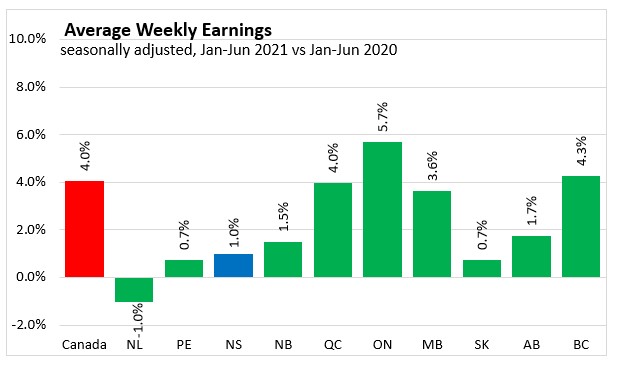
In January-June 2021, average weekly earnings were up 2.0% in Nova Scotia's goods producing sectors over January-June 2020. Goods sector wages were up for construction and manufacturing sectors. Service sector average earnings were up 0.7% in Jan January-June 2021. Service sector earnings increased the most in percentage terms in administration and support services (+9.1%) and finance and insurance (+8.8%). Service sector earnings decreased the most in information and culture.
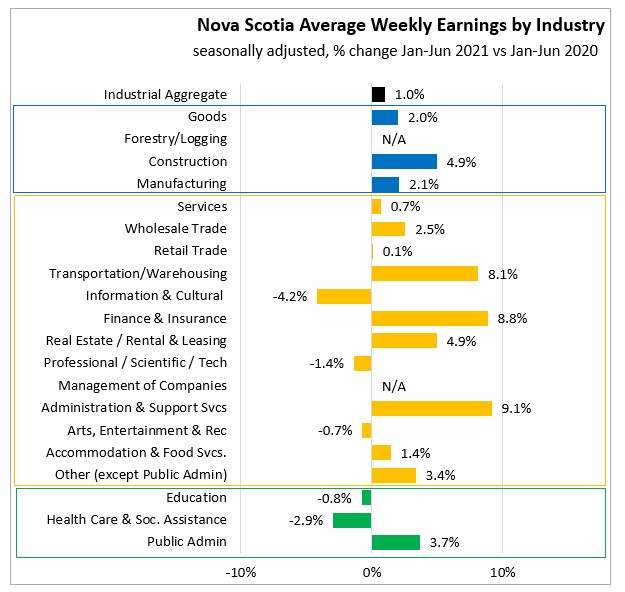
REFERENCE TABLES - (January-June 2021 vs January-June 2020)


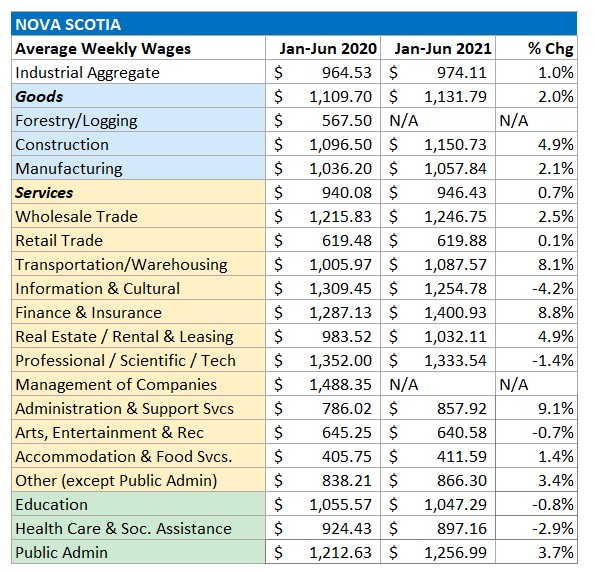
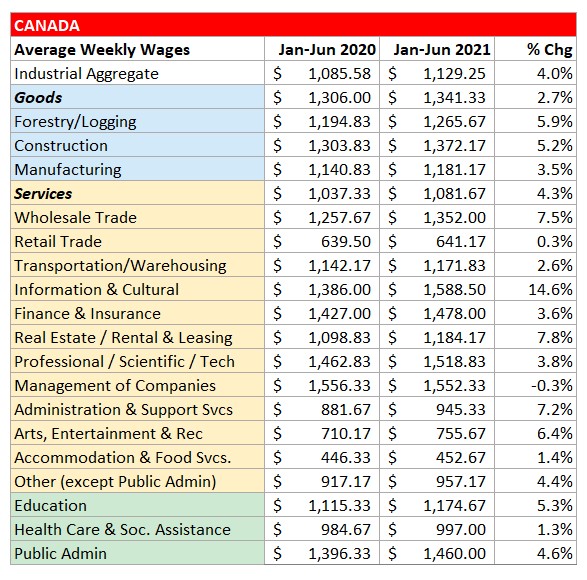
Source: Statistics Canada. Table 14-10-0222-01 Employment, average hourly and weekly earnings (including overtime), and average weekly hours for the industrial aggregate excluding unclassified businesses, monthly, seasonally adjusted; Table 14-10-0223-01 Employment and average weekly earnings (including overtime) for all employees by province and territory, monthly, seasonally adjusted